Cenote Sagrado
Cenote de los Sacrificios - Sacred Cenote - The Well of Sacrifice
Useful Information
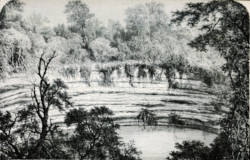
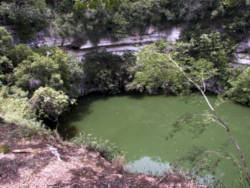

| Location: |
Chichén Itzá.
350 m north of the Kukulcán pyramid.
119 km east of Mérida, 42 km west of Valladolid and 200 km west of Cancún.
(20.687674, -88.567648) |
| Open: |
All year daily 8-17, last entry 16. Kukulkan Nights: All year daily 19. [2025] |
| Fee: |
Adults MXN 648, Children (3-12) MXN 100, Mexican Citizens MXN 290, Locals MXN 100. Kukulkan Nights: Adults MXN 755, Mexican Citizens MXN 355. [2025] |
| Classification: |
 Cenote Cenote
 Gateway to Hell Gateway to Hell
|
| Light: | n/a |
| Dimension: | D=56 m, VR=56 m. |
| Guided tours: |
self guided. V=2,000,000/a [2015] |
| Photography: | allowed |
| Accessibility: | no |
| Bibliography: |
Désiré Charnay (1887):
The ancient cities of the New World : being travels and explorations in Mexico and Central America from 1857-1882
London : Chapman and Hall.
online
Clemency Chase Coggins, Orrin C. Shane (1984): Cenote of Sacrifice: Maya Treasures from the Sacred Well at Chichen Itza: Maya Treasures from the Sacred Well at Chichaen Itzaa, University of Texas Press, 1. Oktober 1984, 176 pp, ISBN-10: 0292710984, ISBN-13: 978-0292710986. Samuel K. Lothrop (1952): Metals from the Cenote of Sacrifice, Chichén Itzá, Yucatan In: Memoirs of the Peabody Museum of Archaeology and Ethnology Harvard University 10, no. 2. Cambridge, MA: Harvard University Press, 1952. Tatiana Proskouriakoff (1974): Jades from the Cenote of Sacrifice, Chichén Itzá, Yucatan In: Memoirs of the Peabody Museum of Archaeology and Ethnology Harvard University 10, no. 1. Cambridge, MA: Harvard University Press, 1974. |
| Address: | Cenote Sagrado. |
| As far as we know this information was accurate when it was published (see years in brackets), but may have changed since then. Please check rates and details directly with the companies in question if you need more recent info. |
|
History
| 415-435 | settlement founded by the Toltec. |
| 6th to 10th century | construction of the most important monuments. |
| 967 to 987 | city conquered by the King of Tula, Ce Acatl Topiltzin Quetzalcoatl aka Kukulkan, exact year unknown. |
| 1842 | diplomat and explorer John Lloyd Stephens visits Chichen Itza. |
| 1904 | start of exploration by the consul and hobby archaeologist Eduard H. Thompsen. |
| 1907 | end of exploration. |
| 1962 | excavated by the National Geographical Society. |
| 1988 | inscribed on the UNESCO World Heritage List. |
Description
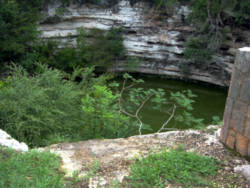
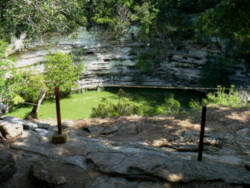
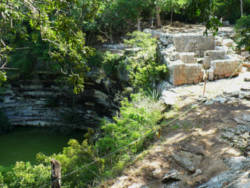
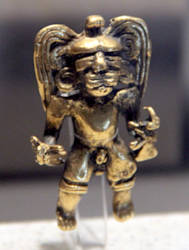
Setting out from the Castillo, we ascended a wooded elevation, which was the largest and wildest we had seen.
In the midst of a thick forest, an immense circular hole, with cragged, perpendicular sides, trees growing out of them and overhanging the brink.
A hawk was sailing around it, looking down into the water, but without once flapping its wings.
The water was of a greenish hue.
A mysterious influence seemed to pervade it, in unison with the historical account that the well of Chichen was a place of pilgrimage, and that human victims were thrown into it in sacrifice.
In one place, on the very brink, were the remains of a stone structure, probably connected with ancient superstitious rites; perhaps the place from which the victims were thrown into the dark well beneath.
John Lloyd Stephens, diplomat and explorer, after he visited Chichen Itza in 1842
Cenote Sagrado (Sacred Cenote) is probably the most famous cenote of all: the giant sacred well at Chichén Itzá. Chichén Itzá is one of the ancient Maja cities, located in the center of the Yucatán peninsula. This cenote was used only for ritual purposes, perhaps as a channel to the Underworld. It is often described as a place of human sacrifice, however, modern archaeology doubts this. But it was never used as a source for drinking water, which came from the Xtoloc Cenote near the Caracol. Mayas generally considered cenotes as holy places, the Yucatec Mayan word dzonot or ts’onot translates sacred well. This cenote however, was thought to be even more sacred and was thought to be a portal into Xibalba, the Maya underworld. This is the reason why we listed it as an entrance to Hell, although the religious systems differ in their terminology. Human sacrifices and valuable objects were thrown into the cenote as offerings.
The cenote was explored by the U.S. Consul and hobby archaeologist Eduard H. Thompsen. Actually he was more a collector and interested in the collected items, not in the scientific research. He bought the land around the ancient city for USD 75 and started to dig. Then he used his position to send the item secretly to the U.S.A., a completely unacceptable behaviour. Obviously the other people found it also unacceptable, and after it became known he had to leave the country immediately.
Thompsen lifted jade, gold, pottery and some 50 skeletons from the cenote. More recent explorations by the Mexican diving team CEDAM revealed many more important discovery. This wealth of finding emphasized the importance of this place as a sacred place.
This is one of the few cenotes, which is not used for swimming. Actually it is forbidden to enter the cenote, it may only be visited from the rim. The water looks green, which is caused by the enormous amount of algae in the water. We therefore assume that it would not be pleasant to swim in such water.
This Pre-Hispanic City of Chichen-Itza was a sacred site and one of the greatest Mayan centres of the Yucatán peninsula. Much of the architecture are temples and pyramids. But there are also two cenotes, caves and artificial tunnels. As they are archaeological excavation sites as well as sacred sites for the indigenous Mayas, access is restricted. To see the Cenote Sagrado, it is necessary to buy a ticket for the city, the cenote is only one of numerous monuments. It’s not possible to visit only the cenote. Also, the visit is normally unguided, but it’s also possible to book a guided tour, but how much this tour actually tells about the cenote depends on the guide. Most tourists visit the site on day trips offered by numerous companies, which are generally booked at the hotel. They include pickup and drop-off, and depending on the tour, refreshments, food, guided tour and more may be included.
The city was founded in the 5th century by the Toltecs who used one cenote for gathering drinking water. In the 10th century, between 967 and 987, the exact year is unknown, the city was conquered by the King of Tula, Ce Acatl Topiltzin Quetzalcoatl aka Kukulkan. As a result, the Maya and Toltec traditions were blended, a phenomenon called acculturation.
Today the site is managed by the Institute of History and Anthropology of Mexico (INAH) and by the Ministry of Culture of Yucatán (Cultur). Both get a share of your entrance fee. There are regular guided tours which take about 2 hours and are offered in Spanish and English, online booking a day ahead is recommended. There is also the possibility to visit Kukulkan Nights, which takes place at 19 daily and is a sort of light and music show.
Aka The Well of Sacrifice, famous for its human sacrifices. The cenote was first dredged by Edward H Thompson, the US Consul in Mérida, between 1904 and 1907. He accumulated a vast quantity of objects in pottery, jade, copper, and gold. In 1962 the National Geographical Society found a further 4,000 artefacts. Another cenote the Xtoloc Well was probably used as a water supply.
Text by Tony Oldham (2004). With kind permission.
- See also
 Subterranean World Heritage List
Subterranean World Heritage List Search DuckDuckGo for "Cenote Sagrado"
Search DuckDuckGo for "Cenote Sagrado" Google Earth Placemark
Google Earth Placemark OpenStreetMap
OpenStreetMap Sacred Cenote - Wikipedia (visited: 04-JUN-2020)
Sacred Cenote - Wikipedia (visited: 04-JUN-2020) Chichen Itza, official website (visited: 14-JUL-2025)
Chichen Itza, official website (visited: 14-JUL-2025) Chichén Itzá’s Sacred Cenote by Savanah Nicole Burns (visited: 14-JUL-2025)
Chichén Itzá’s Sacred Cenote by Savanah Nicole Burns (visited: 14-JUL-2025) Into the Centipede’s Jaws: Sumptuous Offerings from the Sacred Cenote at Chichén Itzá (visited: 14-JUL-2025)
Into the Centipede’s Jaws: Sumptuous Offerings from the Sacred Cenote at Chichén Itzá (visited: 14-JUL-2025) Alfred Maudslay’s 1889 photo of the Sacred Cenote (visited: 14-JUL-2025)
Alfred Maudslay’s 1889 photo of the Sacred Cenote (visited: 14-JUL-2025) Pre-Hispanic City of Chichen-Itza - UNESCO World Heritage List (visited: 14-JULI-2025)
Pre-Hispanic City of Chichen-Itza - UNESCO World Heritage List (visited: 14-JULI-2025)
 Index
Index Hierarchical
Hierarchical Countries
Countries Maps
Maps